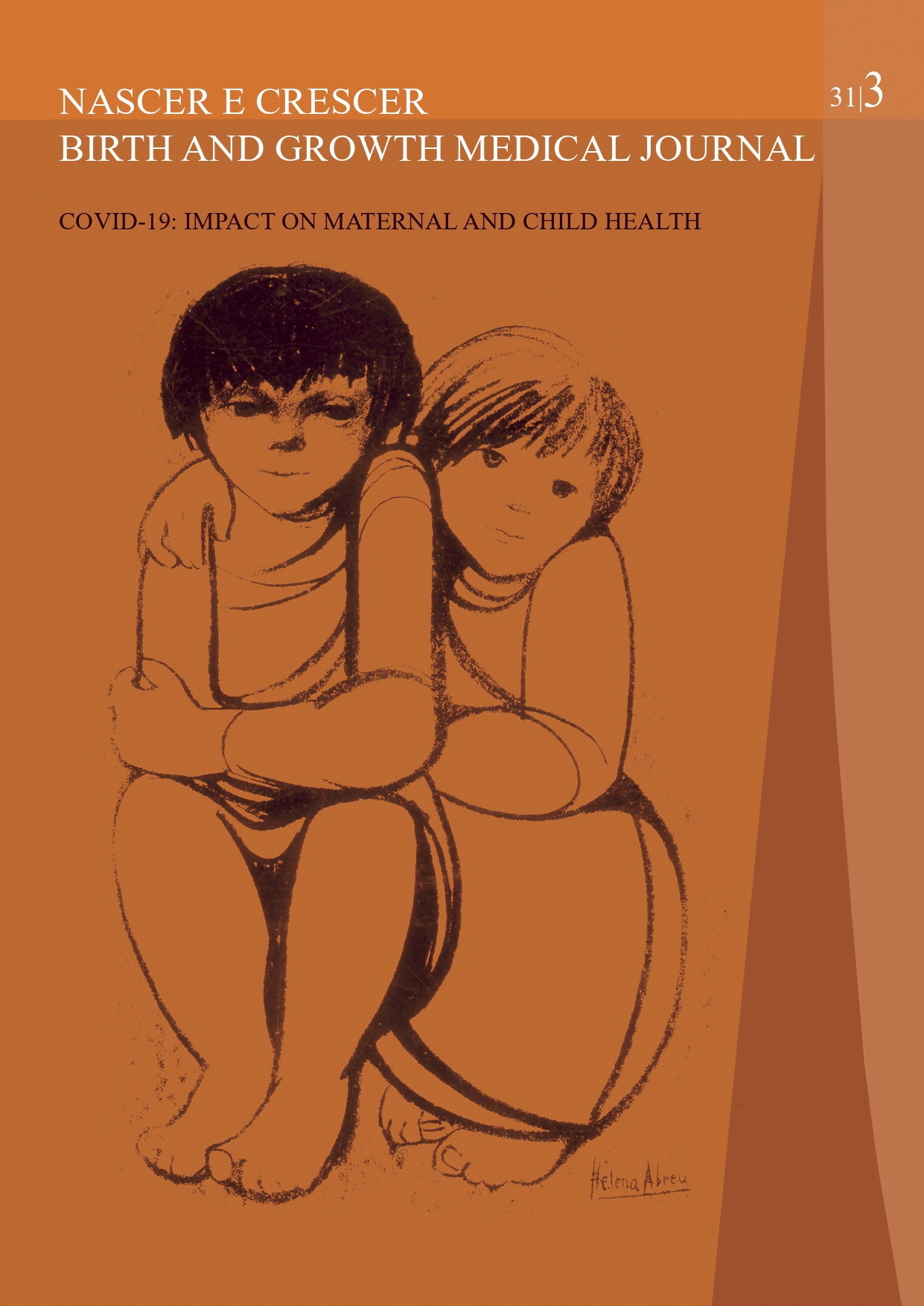Management of SARS-CoV-2-positive mothers and their offspring at the beginning of the COVID-19 pandemic
DOI:
https://doi.org/10.25753/BirthGrowthMJ.v31.i3.24593Keywords:
COVID-19, newborn, pandemic, patient safety, SARS-CoV-2Abstract
Introduction: The uncertainty in SARS-CoV-2 modes of transmission, particularly regarding vertical and peripartum transmission, led national and international organizations to recommend (although not unanimously) the separation of newborns and mothers.
Material and Methods: To characterize the management of offspring of confirmed/suspected SARS-CoV-2-positive mothers in the postpartum, an online questionnaire was sent to Portuguese Pediatric and Neonatology heads of department of the Portuguese National Health Service during April and May, 2020.
Results: Twenty-five out of forty-four questionnaires were retrieved and included in the study. Results showed that healthcare workers (HCWs) wore FFP2 masks and face shield/goggles in 88% of hospitals while assisting in the delivery of offspring of confirmed/suspected SARS-CoV-2-positive mothers. In 8% of hospitals, mothers were allowed to have a labor partner. Newborns were separated from their mothers in 56% of hospitals and were not breastfed in 68%. Five newborns (4%) tested positive for SARS-CoV-2 infection in a universe of 114 mothers with positive SARS-CoV-2 test. Newborn SARS-CoV-2 testing was performed with adequate swabs in 64% of hospitals, but the method employed varied among hospitals. Discharge criteria were also variable, with 45% of hospitals requiring a negative test result of the caregiver.
Conclusion: The use of personal protective equipment by HCPs during delivery of offspring of confirmed/suspected SARS-CoV-2-positive mothers complied with international recommendations. Although vertical transmission is a rare event, this study uncovered a 4% rate of SARS-CoV-2-positive newborns from positive mothers during the considered period. The development of national recommendations has the potential to avoid disparity of procedures among hospitals.
Downloads
References
Trippella G, Ciarcia M, Ferrari M, Buzzatti C, Maccora I, Azzari C, et al. COVID-19 in Pregnant Women and Neonates: A Systematic Review of the Literature with Quality Assessment of the Studies. Pathogens. 2020;9(6):485. https://doi.org/10.3390/pathogens9060485.
Wang SS, Zhou X, Lin XG, Liu YY, Wu JL, Sharifu LM, et al. Experience of Clinical Management for Pregnant Women and Newborns with Novel Coronavirus Pneumonia in Tongji Hospital, China. Curr Med Sci. 2020;40(2):285-289. https://doi.org/10.1007/s11596-020-2174-4.
Zhu H, Wang L, Fang C, Peng S, Zhang L, Chang G, et al. Clinical analysis of 10 neonates born to mothers with 2019-nCoV pneumonia. Transl Pediatr. 2020; 9(1): 51–60. https://doi.org/10.21037/tp.2020.02.06.
Ghema K, Lehlimi M, Toumi H, Badre A, Chemsi M, Habzi A, et al. Outcomes of newborns to mothers with COVID-19. Infect Dis Now. 2021;51(5):435-439. https://doi.org/10.1016/j.idnow.2021.03.003.
Yeo KT, Biswas A, Ho SKY, Kong JY, Bharadwaj S, Chinnadurai A, et al. Guidance for the clinical management of infants born to mothers with suspected/confirmed COVID-19 in Singapore. Singapore Med J. 2021.
https://doi.org/10.11622/smedj.2021045. Online ahead of print.
Pavone P, Ceccarelli M, Taibi R, La Rocca G, Nunnari G. Outbreak of COVID-19 infection in children: fear and serenity. Eur Rev Med Pharmacol Sci. Apr 2020;24(8):4572-4575. https://doi.org/10.26355/eurrev_202004_21043.
Vivanti AJ, Vauloup-Fellous C, Prevot S, Zupan V, Suffee C, Cao JD, et al. Transplacental transmission of SARS-CoV-2 infection. Nat Commun. 2020;11(1):3572. https://doi.org/10.1038/s41467-020-17436-6.
Pace RM, Williams JE, Järvinen KM, Belfort MB, Pace CDW, Lackey KA, et al. Characterization of SARS-CoV-2 RNA, Antibodies, and Neutralizing Capacity in Milk Produced by Women with COVID-19. mBio. 2021;12(1). https://doi.org/10.1128/mBio.03192-20.
Bertino E, Moro GE, De Renzi G, Viberti G, Cavallo R, Coscia A, et al. Detection of SARS-CoV-2 in Milk From COVID-19 Positive Mothers and Follow-Up of Their Infants. Front Pediatr. 2020 Oct 27;8:597699. https://doi.org/10.3389/fped.2020.597699.
Chandrasekharan P, Vento M, Trevisanuto D, Partridge E, Underwood MA, Wiedeman J, et al. Neonatal Resuscitation and Postresuscitation Care of Infants Born to Mothers with Suspected or Confirmed SARS-CoV-2 Infection. Am J Perinatol. 2020 Jun;37(8):813-824. https://doi.org/10.1055/s-0040-1709688.
Park SH. Personal Protective Equipment for Healthcare Workers during the COVID-19 Pandemic. Infect Chemother. Jun 2020;52(2):165-182. https://doi.org/10.3947/ic.2020.52.2.165.
Lu Q, Shi Y. Coronavirus disease (COVID-19) and neonate: What neonatologist need to know. J Med Virol. 2020;92(6):564-567. https://doi.org/10.1002/jmv.25740.
Cavicchiolo ME, Trevisanuto D, Priante E, Moschino L, Mosca F, Baraldi E. Italian neonatologists and SARS-CoV-2: lessons learned to face coming new waves. Pediatr Res. Apr 7 2021.
Lugli L, Bedetti L, Lucaccioni L, Gennari W, Leone C, Ancora G, et al. An Uninfected Preterm Newborn Inadvertently Fed SARS-CoV-2-Positive Breast Milk. Pediatrics. 2020 Dec;146(6):e2020004960. https://doi.org/10.1542/peds.2020-004960.
Parazzini F, Bortolus R, Mauri PA, Favilli A, Gerli S, Ferrazzi E. Delivery in pregnant women infected with SARS-CoV-2: A fast review. Int J Gynaecol Obstet. Jul 2020;150(1):41-46. https://doi.org/10.1002/ijgo.13166.
Saúde DGd. Orientação 026/2020: “COVID-19: Cuidados ao Recém-nascido na Maternidade” de 19/05/2020, atualizada a 20/03/2021. Serviço Nacional de Saúde.
Perl SH, Uzan-Yulzari A, Klainer H, Asiskovich L, Youngster M, Rinott E, et al. SARS-CoV-2-Specific Antibodies in Breast Milk After COVID-19 Vaccination of Breastfeeding Women. JAMA. 2021;325(19):2013-2014. https://doi.org/10.1001/jama.2021.5782.
Sanchez-Luna M, Fernandez Colomer B, de Alba Romero C, Allen AA, Souto AB, Longueira FC, et al. Neonates Born to Mothers With COVID-19: Data From the Spanish Society of Neonatology Registry. Pediatrics. 2021;147(2):e2020015065. https://doi.org/10.1542/peds.2020-015065.
Downloads
Published
How to Cite
Issue
Section
License
Copyright (c) 2022 Mariana Isabel Lopes da Costa, Beatriz Vala, Joana Aquino, Bilhota Xavier

This work is licensed under a Creative Commons Attribution-NonCommercial 4.0 International License.
Copyright and Authors' Rights
All articles published in Nascer e Crescer - Birth and Growth Medical Journal are Open Access and comply with the requirements of funding agencies or academic institutions. For use by third parties, Nascer e Crescer - Birth and Growth Medical Journal adheres to the terms of the Creative Commons License "Attribution - Non-Commercial Use (CC-BY-NC)".
It is the author's responsibility to obtain permission to reproduce figures, tables, etc. from other publications.
Authors must submit a Conflict of Interest statement and an Authorship Form with the submission of the article. An e-mail will be sent to the corresponding author confirming receipt of the manuscript.
Authors are permitted to make their articles available in repositories at their home institutions, provided that they always indicate where the articles were published and adhere to the terms of the Creative Commons license.


